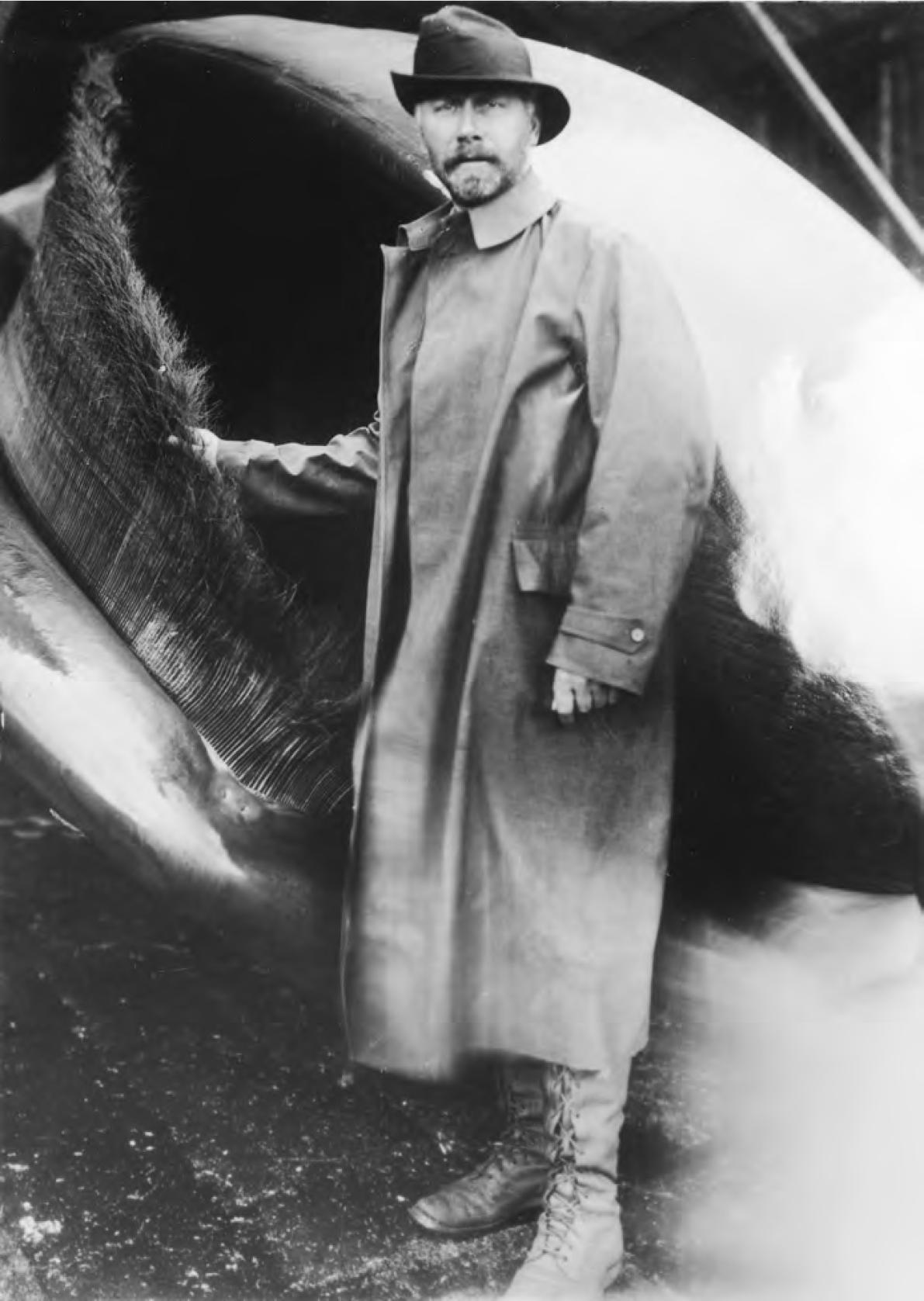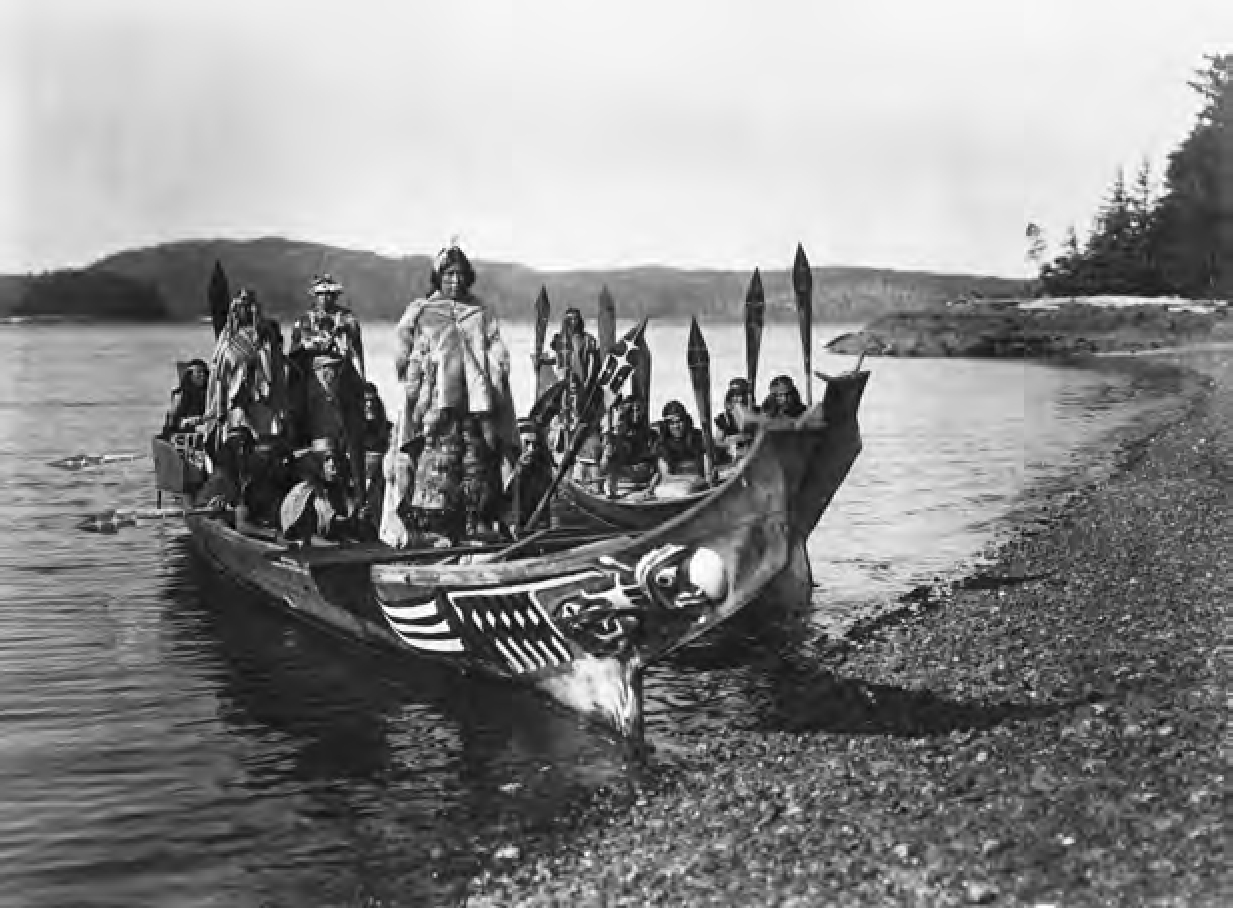Read Short Nights of the Shadow Catcher Online
Authors: Timothy Egan
Short Nights of the Shadow Catcher (34 page)

The most difficult shots would be the action scenes at sea, and for that the filmmaker
would need cooperative beasts. Curtis purchased a massive, fresh-killed whale from
a commercial outfit up the coast, north of Prince Rupert, and had it towed to a Kwakiutl
village. The whale worked for his hunt scene, and Curtis was so proud of his trophy
prop that he posed in front of its maw of comblike baleen. He looks small by comparison,
but the pride shows on his face.
For the sea lion shots, Curtis, Myers and Stanley Hunt took off for a distant rookery,
miles from shore and sheltered harbor. There, the lions, some of them two thousand
pounds and up to thirteen feet long, hauled out on a scuff of exposed land called
Devil Rock. The crew clambered onto the rock, which Curtis measured at 300 by 500
feet. Curtis marveled at the clack of barking, behemoth lions, the males rounding
up their harems, lords of the North Pacific, the smaller females in heat. The trio
offloaded packs with cameras, dried food, notebooks, a tent and bedrolls, and Hunt
paddled away, planning to pick up the men the next day. They intended to spend a night
in order to film the lions at least twice at low tide. The boat had no sooner left
than Curtis made a startling discovery: there was no plant life on the island. No
ferns, no small shrubs of any sort, no grass, no beach mud. Instead, they found anemones,
shallow tidal pools, shiny mussels clinging to wet rock.
“Do you understand the situation?” asked Myers, some panic in his voice. “There’s
no driftwood on this island!”
Their chart had shown Devil Rock to be forty feet above sea level. And when they landed
at low tide, that looked accurate. But it was now clear that this speck of land would
be completely submerged at high tide.
“Yes, Myers. I understand.”
Either the chart was wrong or they had the wrong island. It was midafternoon. By midnight,
in Curtis’s calculation, they would be drowned. The water temperature in that part
of the Queen Charlotte Islands is rarely above 40 degrees, even in the warmest months.
A person could live for perhaps thirty minutes before severe hypothermia set in, and
then death. Looking around, Curtis could not find a stray log from which to fashion
a primitive raft or float. Still, they worked, shooting the sea lions in a boisterous
ritual—magnificent footage, never seen onscreen. Then they made for the highest ground
and waited. As evening set in, the edge of their temporary island disappeared. They
double- and triple-wrapped their cameras. Sunset was late, well past 10 p.m., and
the land slipped away faster than the light. Near midnight, the sea was calm but the
water completely covered Devil Rock. From where the men stood they saw nothing but
the flat gray plane of the Pacific. A light wind picked up, and sea lions flopped
about. Spray lashed the men’s faces. The water inched up and over their boots, to
the ankles, the knees. The tide had to peak—but when? The fear was that a big breaker
would come along and carry them out to sea. They shivered, trading gallows cracks.
Deep in the summer night, an hour or so before the first streaks of a new day’s pink
appeared in the east, the sea seemed to settle, just below their waists.
Back in Prince Rupert, the Canadian authorities launched a search party. The great
Edward Curtis was long overdue, and thought to be lost in the disorienting fog of
the Queen Charlottes. A story went out by telegraph and was picked up by the wire
services. The
New York Times
prepared a lengthy—and largely adulatory—obituary.
When Hunt arrived in his large canoe in the afternoon, he found a trembling, wet crew
of filmmakers and his youngest son, the blood drained from his face. They were battered
from stumbling on the slick rock, exhausted from the night and the tension, but otherwise
in decent shape. The film had been saved.
Hunt started laughing. “I knew you were all dead!”
So did the
New York Times.
A writer who had interviewed Curtis earlier for a profile had been assigned the obituary.
He spent several days on the piece before news came that Curtis had survived. Months
later, when the writer saw Curtis in New York, he scolded him.
“The next time you drown,” he told Curtis, “please stay drowned.”
They shot 112 scenes in all, enough footage to edit down to six reels, about an hour.
By the close of July, Curtis had his film, including the battle scenes, clashes between
clans using spears and wooden clubs. At the same time, the muscle-flexing monarchies
of Old Europe and the ossified rulers of the Ottoman Empire were rumbling into war.
The assassination of Archduke Ferdinand of Austria, on June 29, 1914, was the first
ripple. Soon, four of the world’s great empires would be drawn into close-range carnage
with ghastly industrial weapons, a war that would end in the collapse of two of them.
For Curtis, happy to be finishing
In the Land of the Head-Hunters,
the guns of the Great War could not have been farther away. He called it a wrap and
set sail for Seattle on the
Elsie Allen.
The film opened in New York and Seattle in December of 1914. The editing had been
exhausting, much more so than Curtis had expected, plus he had color-tinted scenes
for added effect, a time-sucking task. Curtis missed Muhr—his judgment, his sharp
eye, his work ethic. But he still had Myers, and gave him grateful credit when he
applied the finishing touches to Volume X that winter, while balancing film and writing
duty. “Mr. W. E. Myers, who has been so long identified with
The North American Indian,
has done his best work here, and to his valuable collaboration much of the success
of this volume is due.” Curtis sent a note to subscribers, with some self-congratulation
at having reached the halfway point of the twenty volumes.
At the film’s premiere, Curtis employed an orchestra that played a score composed
by John J. Braham, who was known for his work with Gilbert and Sullivan. Braham had
worked from wax cylinder recordings of Kwakiutl songs brought back by Curtis. The
movie posters showed giant carved raven heads swallowing a nearly naked man; it looked
like early 3D, promised “Eight thousand feet of tinted pictures by the world’s master
photographer!” Handbills proclaimed, “Every participant an Indian and every incident
true to native life.” A tag line on one poster read:
AN ABORIGINAL ROMANCE
EDWARD CURTIS’S WONDERFUL
INDIAN PHOTO DRAMA
The movie was a smash—with the critics. “A gem of the motion picture art,” wrote W.
Stephen Bush, a prominent early film writer. “Mr. Curtis has found the short cut of
genius and he eminently succeeds where others have dismally failed.” He added, “I
speak advisedly when I say that this production sets a new mark in artistic handling
of films in which education values mingle with dramatic interest . . . It is not a
feature for the nickelodeon or the cheap house, but it ought to be welcomed by the
better class of houses . . . that want to give their patrons a special treat.” The
poet Vachel Lindsay, writing in a book on the value of film, praised Curtis for “a
supreme art achievement” and gave him credit for breaking ground on a number of fronts—location
shooting, story, native cast. Even the scholars weighed in with positive notices.
“The settings, costumes and the incidents themselves were also ethnologically correct
and the dramatic interest of the play was well-sustained,” wrote Alanson Skinner,
of the American Museum of Natural History, in a note to Curtis. “I think you have
succeeded in making ethnology come alive.” At the initial showings at the Casino Theatre
in New York—tickets 25 cents for a matinee, 50 cents for an evening show—crowds gave
the film standing ovations. Audiences particularly liked the sea lion scene shot on
Devil Rock. The
New York Times
praised a story told “entirely from the Indian viewpoint” and marveled at the tinted
scenes, crediting Curtis with a real advance in motion-picture art by creating “new
color systems.” At the Moore Theatre in Seattle, reaction was equally strong. “A powerful,
gripping story,” wrote the critic for the
Post-Intelligencer.
“A genuine sensation.” The show business trade paper
Variety
could not get over the realism, and was astonished that every actor in the film was
“a genuine American Indian.” (Though in fact they were Canadian Indians.)
In production, the film had gone over budget; the total cost was in excess of $75,000—no
surprise, given the maker. A weeklong run in a half-dozen cities had grossed $3,269—not
disastrous, but not promising either. But a dispute with a distributor over who would
pay to get the movie into wide release put it in limbo. The film was pulled, pending
litigation. Curtis could not believe it. He’d produced another masterpiece, as it
was called, and nobody was going to see it. Would it rot in a basement, all that action,
the world’s first in a class? The investors who’d been promised sizable returns raised
a caterwaul. Curtis could not sleep, could not eat. He paced his room at the Belmont
and burned up phone and telegraph lines in the city. He filed suit against the distributor,
claiming it had broken their agreement. But the suit was slow to get anywhere. Meanwhile,
the courts held
In the Land of the Head-Hunters
hostage.
“I am sparring for my life and gasping for breath and at the same time working so
hard that I am worn to more than the old time thin edge,” Curtis wrote Hodge.
Eight years after
In the Land of the Head-Hunters
had opened and mysteriously vanished, a silent film titled
Nanook of the North—A Story of Love and Life in the Actual Arctic
was released in theaters around the world. Its director, Robert Flaherty, had studied
the Curtis movie frame by frame and spent an afternoon with the Shadow Catcher, asking
him about his methods, his location ideas, how to work with native people. Flaherty
had tried to do a film on Eskimos at the same time that Curtis was finishing
Head-Hunters,
and his earlier effort was pedestrian. As a professional courtesy, Curtis explained
how he built sets based on native models, hired only Indian actors and generally tried
to create a lost world in an authentic way. When Flaherty set out to make
Nanook,
he followed the Curtis model. The film was shot near Hudson’s Bay. Igloos were built.
Costumes from the old days were made fresh for the film. Scenes showed traditional
hunting, hut-making and meat-drying, and included a thrilling sequence with Nanook
hunting seals by spear. The Flaherty film was a huge success, and he was credited
with making the first feature-length documentary.
Two years later, in 1924, Curtis sold all rights to his film to the American Museum
of Natural History for $1,500 and shipped the master print and negative to New York.
The litigation had never been settled; the case had died in court. The film was bound
for a vault in the museum; it was an artifact, a forgotten one at that.

taken during the filming of Curtis’s
In the Land of the Head-Hunters.

Curtis with a breakthrough film—shot entirely on location, using an all-native cast—that
was largely forgotten for much of the twentieth century.

a mythic story of the Kwakiutl.
